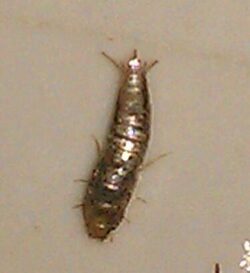Silverfish
 For fast, professional elimination of silverfish call 1-877-882-4403 to book your appointment or complete the contact form on this page. Our below article offers you some ideas for prevention of silverfish, natural repellents and even DIY methods to get rid of them. However, for large infestations, professional service is highly recommended.
For fast, professional elimination of silverfish call 1-877-882-4403 to book your appointment or complete the contact form on this page. Our below article offers you some ideas for prevention of silverfish, natural repellents and even DIY methods to get rid of them. However, for large infestations, professional service is highly recommended.
How to Keep Silverfish at Bay
Silver-gray, scaly, torpedo-shaped silverfish -- Lepisma saccharina Linnaeus -- hide in dark, moist and warm areas of homes. When caught by surprise or suddenly exposed to light, these pest insects of the primitive order Thysanura, scurry away in a side-to-side wiggling motion much like their namesake, fish.
An unsightly nuisance, silverfish -- also known as bristletails or fish moths -- can cause significant damage to paper products, clothing, some foods and other articles. Implementing simple preventive measures, setting out natural, eco-friendly repellents and using non-toxic extermination methods can help you get rid of these elusive critters for good.
Identification and Biology
Long, multi-segmented antennae and three long, slender, tail-like abdominal appendages give the ½-inch-long, flat-bodied silverfish a much larger, imposing appearance. Despite its unpleasant visage, this wingless, nocturnal pest doesn’t bite or carry diseases, but they are prolific breeders laying up to 100 smooth, white eggs that hatch into tiny replicas of the adult silverfish. Over the course of two to four months, the baby silverfish called nymphs moult several times and grow scales, gradually developing into adults with an average two-year life span.
Where They Live
Silverfish inhabit humid places that maintain a moderate to warm temperature of 60-to-85 F. Their infestations are common in the following areas: basements, lower floors, crawl spaces, bathrooms, laundry rooms, kitchens, closets and attics, Silverfish are attracted to pockets of moisture in sinks, showers and around water pipes and often found in cluttered areas of the home. You may find them or their shed exoskeletons in boxes and cabinets, insulation, behind baseboards, electrical outlets, paneled walls, light fixtures and holes where water pipes enter walls.
What They Eat
Silverfish patrol their environment at night when you’re less likely to encounter them. They feed on damp wallpaper, dandruff, hair, shampoos, cellulose, book bindings, photos, carpet, paint, plaster, packaged foods, sugar, flour, coffee grounds, tapestries, cotton, linen, silk, dead insects and their own moulted exoskeletons.
Preventive Measures
Like most pest insects, silverfish enter the home through miniscule cracks and crevices in the walls, floors and foundation. Seal as many of these entry points as possible with caulk, steel wool or sheet metal. Reduce hiding places by de-cluttering. Discard stacks of old newspapers and magazines. Remove food particles, dust and debris with regular vacuuming, sweeping and dusting.
Eliminate Moisture
Dehumidifiers and exhaust fans help control extra-damp rooms. Fix leaky pipes and wrap insulation around sweating pipes, particularly in laundry rooms, kitchens and bathrooms. Remove mold and mildew in bathrooms and basements, and ensure that damp, dark or unused rooms are well-ventilated. Always turn on bathroom exhaust fans when showering, bathing or running hot water.
Proper Storage of Paper Goods and Foodstuffs
Protect your photos and paper-based mementos by storing them in a cedar chest or an air-tight container. Remove open or packaged foods from counters and store dry foodstuffs in air-tight containers in cupboards or in the refrigerator. If you detect any signs of a silverfish infestation, place your books and magazines in air-tight containers.
Natural Repellents
In addition to entering through cracks and crevices on the outside perimeter of homes, silverfish can be introduced via store-bought goods, travelling incognito inside cardboard cartons and food packaging or in library books and magazines. Make your home inhospitable to them with natural, earth-friendly repellents that offend their olfactory senses, driving them to seek shelter elsewhere. Take care to place repellents in areas that are inaccessible to children and pets.
* Sprinkle loose cedar shavings or sachets in potential hiding spots such as linen closets and behind appliances and furnishings.
* Throw mothballs into crawl spaces, attics and other enclosed areas to repel silverfish, other insects and rodents.
* Fill a spray bottle with water and the juice and rind of oranges or lemons and spritz kitchens and bathrooms regularly to keep silverfish at bay.
* Place cucumber, orange or lemon peels in inconspicuous areas of your home that are potential hiding places for silverfish -- replace regularly with fresh ones.
* Many different herbs repel silverfish and other insects. Whole cloves or crushed dried lavender, rosemary, mint, sage or bay leaves work wonders to repel silverfish and other insects. Scoop the herbs into squares of cheesecloth, tie into little bundles and tuck into bookshelves, closets and other nooks and crannies silverfish may be hiding.
* Lavender essential oil is a potent deterrent to silverfish. Fill a spray bottle with water, add about 10-to-15 drops of oil and fan spray the inside of the bathroom vanity, baseboards, outside surfaces of appliances and dark corners. You may also spritz the air in bathrooms and basements.
How to Trap Silverfish
Trapping is another natural option to get rid of silverfish. Make a simple trap with several layers of newspaper loosely rolled into a cylinder and secured with a wide elastic band. Place the traps alongside and behind appliances. Monitor your traps and depending on the level of silverfish infestation, you’ll soon have individuals climbing into the folds of newspaper. To remove, quickly grab the traps and place them into a plastic garbage bag, twist the top tightly and secure with a tie. Discard the bag outside.
For mason jar traps, fill jars wth soapy water and rub some sugar around the opening. Wrap masking tape around the outside to assist the silverfish in climbing in. Once they’re inside the jar, they can’t climb out. Pour into the toilet or discard outside.
Place store-bought insect traps or two-sided carpet tape around the perimeter of rooms to catch silverfish as they move from room to room. Monitor the traps and discard when full.
Non-Toxic Extermination Methods
If you eschew chemical pesticides, consider non-toxic extermination methods such as diatomaceous earth or boric acid. These products penetrate the silverfish’s tough exoskeleton and dessicate, or dehydrate, its soft body.
Prior to the application, clean and disinfect cabinets and drawers and along floors where they meet the wall. Let dry thoroughly. Wearing a dust mask, safety glasses and latex gloves, dust cracks and crevices and the perimeter of the room with diatomaceous earth or boric acid.
* Food-grade Diatomaceous Earth is a powder composed of the fossilized remains of marine phytoplankton.
* Boric acid was historically used as a cleaning agent.
by Susan Dorling - All Rights Reserved

